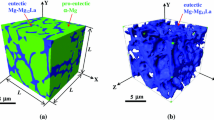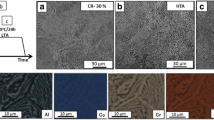Abstract
The structural compliance of the spatially interconnected intermetallic network in a squeeze-cast MRI230D alloy was determined using focused ion beam (FIB) data and finite element (FE) modeling, and compared with data for a high-pressure die-cast AZ91D and three binary Mg-RE alloys from the existing literature. The respective elastic responses were sorted out into two characteristic behaviors: for eutectic volume fractions less than ~22% the behavior was akin to that of highly compliant, bending-dominated structures, whereas for larger fractions, it reproduced that of structurally efficient, stretch-dominated microtruss structures. In all cases, the contribution from the interconnected network added to the total strength of the alloy an amount comparable with the strengthening expected from a similar volume fraction of dispersed particles. Being more compliant, the bending-dominated structures appeared less prone to developing damage by cracking at low strains than the stretch dominated ones.








Similar content being viewed by others
Notes
RE denotes a Ce-rich misch-metal containing 51.7 mass% Ce, 23.1 mass% La, 18.6 mass% Nd, and 6.5 mass% Pr.
In more practical terms, the modeling assumes that the eutectic intermetallic constrains the eutectic α-Mg in such a way that both composite’s components remain elastic until the intermetallic cracks at 0.7% strain.
Because the reinforcing intermetallic or the whole eutectics are assumed either as a solid ceramic skeleton (AZ91D) or as a long fiber composite (other alloys), microstructural parameters such as grains size are not considered. There would be a grain size effect in the case of the whole eutectics through a Hall–Petch effect associated with the lamellar spacing25 but only for plastic strains, which are beyond those considered for the current modeling.
Because the modeling concentrates on the reinforcing by the network, the differences in the alloys chemical composition are reflected only in the elastic constants of the intermetallics, as given by the E i values in Table IV and are made evident (through Eq. 4) by the slope of the lines through the origin in Fig. 4. There is some effect of E i (through Eq. 5) on the dispersion-hardening component as well. Solid-solution effects on the overall strength of the alloys are not considered, but it should be kept in mind that they are solute specific and can be quite significant, see for example Ref. 6.
The Voigt’s bound assumes all microtrusses aligned parallel to the stress axis (see diagrams in Table VI). In the SD configuration, only 1/3 of the interconnected branches are loaded in tension, with the rest orientated across the tensile axis. In the BD configuration, loads are transmitted exclusively through elastic bending of the microtrusses.32
References
C.H. Cáceres, W.J. Poole, A.L. Bowles, and C.J. Davidson, Mater. Sci. Eng. A 402, 269 (2005).
K.V. Yang, A.V. Nagasekhar, C.H. Caceres, and M.A. Easton, Mater. Sci. Eng. A 542, 49 (2012).
D. Amberger, P. Eisenlohr, and M. Göken, Acta Mater. 60, 2277 (2012).
B.S. Shin, J.W. Kwon, and D.H. Bae, Met. Mater. Int. 15, 203 (2009).
A.V. Nagasekhar, C.H. Cáceres, and C. Kong, Mater. Charact. 61, 1035 (2010).
B. Zhang, S. Gavras, A.V. Nagasekhar, C.H. Caceres, and M.A. Easton, Metall. Mater. Trans. A 45, 4386 (2014).
B. Zhang, A.V. Nagasekhar, X. Tao, Y. Ouyang, C.H. Caceres, and M. Easton, Mater. Sci. Eng. A 599, 204 (2014).
B. Zhang, A.V. Nagasekhar, T. Sivarupan, and C.H. Caceres, Adv. Eng. Mater. 15, 1059 (2013).
A.V. Nagasekhar, C.H. Cáceres, and C. Kong, J. Phys.: Conf. Series 240 (2010).
A.V. Nagasekhar, M.A. Easton, and C.H. Cáceres, Adv. Eng. Mater. 11, 912 (2009).
T.L. Chia, M.A. Easton, S.M. Zhu, M.A. Gibson, N. Birbilis, and J.F. Nie, Intermetallics 17, 481 (2009).
Y. Terada, N. Ishimatsu, Y. Mori, and T. Sato, Mater. Trans. (JIM) 46, 145 (2005).
B. Cantor and G.A. Chadwick, J. Mater. Sci. 10, 578 (1975).
M. Sahoo and R.W. Smith, Metal Sci. 9, 217 (1975).
D. Stalling, M. Westerhoff, and H.-C. Hege, Visualization and Mathematics (Berlin: Springer, 1997).
K. Ozturk, Y. Zhong, A.A. Luo, and Z. Liu, JOM 40 (2003).
O.C. Zienkiewicz and R.L. Taylor, The Finite Element Method (Columbus: McGraw-Hill Book Company, 1989).
D. Hull, An Introduction to Composite Materials (Cambridge: Cambridge University Press, 1981).
C.H. Cáceres and P. Lukác, Phil. Mag. A 88, 977 (2008).
N. Wang, Y. Wei-Yang, B.-Y. Tang, L.-M. Peng, and W.-J. Ding, J. Phys. D 41, 195408 (2008).
H. Zhang and S. Wang, Acta Metall. Sinica 48, 889 (2012).
T. Sumitomo, C.H. Cáceres, and M. Veidt, J. Light Metals 2, 49 (2002).
H. Anton and P.C. Schmidt, Intermetallics 5, 449 (1997).
J. Wrobel, L.G. HectorJr, W. Wolf, S.L. Shang, Z.K. Liu, and K.J. Kurzydlowski, J. Alloy Compd. 512, 296 (2012).
R.W. Armstrong, The Yield and Flow Stress Dependence on Polycrystal Grain Size, ed. T.N. Baker (London: Applied Science Publishers, 1983), pp. 1–31.
M.F. Ashby and Y.J.M. Brechet, Acta Mater. 51, 5801 (2003).
L.J. Gibson and M.F. Ashby, Proc. R. Soc. Lond. A 382, 43 (1982).
S.K. Maiti, L.J. Gibson, and M.F. Ashby, Acta Metall. 32, 1963 (1984).
G. Bruno, A.M. Efremov, A.N. Levandovskyi, and B. Clausen, J. Mater. Sci. 46, 161 (2011).
A.P. Roberts and E.J. Garboczi, J. Am. Ceram. Soc. 83, 3041 (2000).
V.J. Challis, X. Xu, L.C. Zhang, A.P. Roberts, J.F. Grotowski, and T.B. Sercombe, Mater. Des. 63, 783 (2014).
V.S. Deshpande, M.F. Ashby, and N.A. Fleck, Acta Mater. 49, 1035 (2001).
C.H. Cáceres, J.R. Griffiths, and P. Reiner, Acta Mater. 44, 15 (1996).
C.H. Cáceres, Alum. Trans. 1, 1 (1999).
Y. Brechet, J.D. Embury, S. Tao, and L. Luo, Acta Metall. Mater. 39, 1781 (1991).
C.H. Cáceres and J.R. Griffiths, Acta Mater. 44, 25 (1996).
P.J. Withers, W.M. Stobbs, and O.B. Pedersen, Acta Metall. 37, 3061 (1989).
L.M. Brown and W.M. Stobbs, Phil. Mag. 23, 1185 (1971).
H.E. Friedrich and B.L. Mordike, Magnesium Technology: Metallurgy, Design Data, Automotive Applications (New York: Springer, 2006).
Acknowledgements
The authors are indebted to Dorothea Amberger (Universitat Erlangen-Nurnberg) for the squeeze-cast plate used in the study.
Author information
Authors and Affiliations
Corresponding author
Rights and permissions
About this article
Cite this article
Zhang, B., Yang, K.V., Nagasekhar, A.V. et al. Deformation Behavior of the Percolating Eutectic Intermetallic in HPDC and Squeeze-Cast Mg Alloys. JOM 66, 2086–2094 (2014). https://doi.org/10.1007/s11837-014-1147-0
Received:
Accepted:
Published:
Issue Date:
DOI: https://doi.org/10.1007/s11837-014-1147-0




